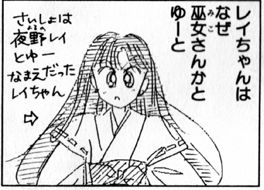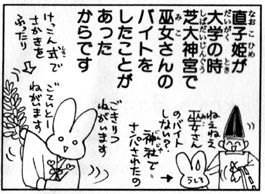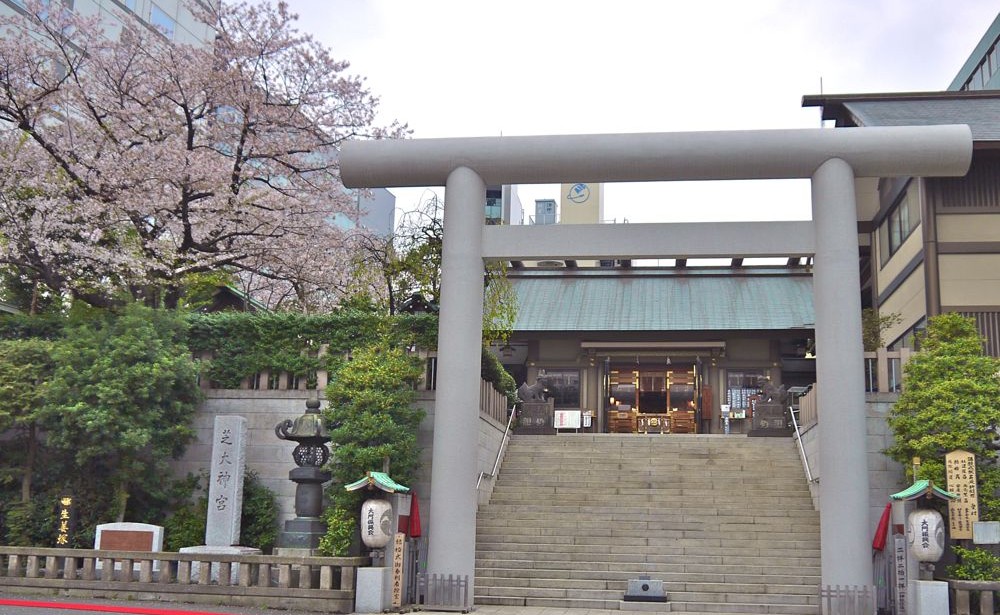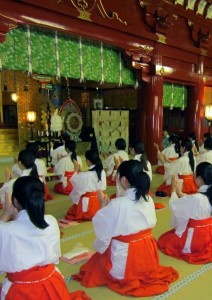The answer to this question can be really short or surprisingly quite long, depending on how deep you want to get into it. Of course, the quick and easy answer is that “Rei is a miko because she lives at a Shinto shrine,” but like most things in the Sailor Moon universe, things aren’t that simple (nor would it be interesting if they were!). We’ve already discussed the interesting religious (in)significance of Rei attending a Catholic school, so let’s take a closer look at the inspirations behind her more obvious religious affiliations!
Fortunately for us, Ms. Takeuchi directly addresses this question in her ~~ Punch! question and answer segment added to the end of the re-released manga volumes around 2003/2004 (the shinsouban; “new editions”).1
If you were to ask me why I made Rei into a miko…
→ Originally, Rei was going to be named Rei Yoruno (‘Rei of the Night’)
One of the things that I find fascinating about this story here is not only the background of how Rei came to get her religious affiliation, but I really do like her original last name. Though obviously the fire affinity fits in better with the Mars/Fire connection in Japanese, I think the original name and its connection with the night ties in neatly with the word play on ghosts/beauty in Rei’s name.
So what does Ms. Takeuchi have to say on the subject?
… it’s actually because I had worked part time as a miko at Shibadaijingu when I was a university student.
I waved evergreen branches at weddings… things like that.
Bow your head and pray! Stand up and pray!Priest: Hey there, how’dya like to be a miko?
Naoko: I got hit on at a shine!
It turns out the inspiration behind Rei being a miko is actually tied to Ms. Takeuchi’s first-hand experience as one herself, during her college days. So it’s a pretty open and shut case, right?
Well, of course it isn’t. On the surface it sounds totally logical, but when you remember what we said at the very beginning – that Rei is a miko because she lives at a Shinto shrine – that doesn’t quite fit with what we know about Ms. Takeuchi’s background.2 Isn’t this some sort of holy position that takes years of study and religious devotion? How could Ms. Takeuchi have been a part-time Shinto priestess? This is where things actually get interesting.
I’ve actually known about this for several years now, due to a story one of my female friends told me about her days as a part-time miko over the New Year holidays. However, I never had a chance to research it until today. Now, this isn’t to say that all miko are just university students out for cash – that’s an over-simplification – but the majority attending weddings and over the busy seasons are, let’s say, seasonal workers.
So what does it take to be a part-time priestess? What are the perks? How about the downsides? Well, fortunately for us, there are websites devoted to miko-hopefuls that should answer some of our questions.3
What’s Involved in Being a (Part-Time) Miko?
The answers will differ for every shrine, but taking a look at the application page for Kandamyoujin,4 we can see it’s generally in line with what you expect to see when visiting a shrine:
Qualifications:
- Female
- Between 18 and 25 years old
- Unmarried
- Living within 1 hour of the shrine
Working Conditions:
- 8-hour shifts (or a 9-hour shift from 11pm on 12/31 to 8am on 1/1)
- Clothing allowance
- Lunch is provided (and dinner for the 12/31~1/1 group)
Prohibited:
- No excessive makeup, fake eyelashes, manicures, piercings, or accessories
- Cell phone use is prohibited
- May not drink any alcohol
- No brown or dyed hair or perms
- No posting on social networks
- No “anything else the shrine deems inappropriate”
Taking all these things together, basically the goal is to retain the image of purity – a key tenet of Shinto.5
The last all-important-question that I’m sure everyone is dying to know about (or, at least, I was) is: just much much can one expect to earn from being a part-time shrine priestess over the holidays or for weddings?
Unfortunately, the shrines are pretty tight-lipped on this themselves since they don’t really want to make it look like simply a normal job, but the internet does provide us with some numbers:6
It varies quite a bit from shrine to shrine, but you can expect to make ¥700 to ¥1,200 if paid hourly or ¥8,000 to ¥10,000 if paid daily. For some context, a normal part-time job will pay around ¥900 – 1,000 an hour in Tokyo, though that same job would pay ¥830 an hour in Hokkaido.7
Well, this veered off on quite a bit of a tangent from what we set out to learn today, but I think it all wound up being pretty interesting! Though Rei’s situation is a little different, since she is a full-time shrine priestess (in addition to being a sailor-suited warrior fighting for love and justice and junior high student!), it’s nice to know that Ms. Takeuchi actually did put a bit of herself into Rei!
References:
- See vol. 3, p. 237 of the re-released shinsouban ↩
- See Naoko Takeuchi (Wikipedia) ↩
- See Part-Time Miko (Japanese) ↩
- See Kandamyoujin – Miko Application ↩
- See Shinto Purity (Wikipedia) ↩
- See Part-Time Miko (Pay) ↩
- See Average Part-Time Pay by Region ↩






Ohh interesting. I did wonder why all the priestesses I saw in Japan had basically no makeup on and black hair xD
What’s interesting about that is that it isn’t just priestesses – a lot of jobs (e.g., flight attendants, hotel workers, and banquet staff at hotels and wedding halls) here require that you only have black hair. It seems so weird to me as an American that your company can demand so much. My flight attendant friend even has dress codes for what she wears TO AND FROM work. Wow…
hahaa yeah, I think it’s an Asian thing actually. There’s this old-fashion idea that girls who dye their hair are rebellious in nature and aren’t as..hardworking?? XDDD
That and the cost-benefit ratio is good for the company. Costs you nearly nothing in lost employees by demanding black hair, and very little risk of customers complaining… so win-win!
Completely unrelated to anything, but that’s one reason why Starbucks is so appealing as an employer to university students — piercings are okay, and so is hair dye. Oh, and everyone wants to tell their friends they work at Starbucks. ^_-
It’s also woven into the uniform code of some schools–or at least it used to be. Occasionally you’ll come across an anime or manga plot about a girl getting into trouble because her natural hair isn’t bone-straight or black. Just from superficial observations, the requirement might have laxed in recent years.
A surprising amount of schools still require it, which is amazing to me. I think it was around ~60% of Tokyo high schools have a strict hair color requirement last I checked.
Of course, many of the… less highly-ranked schools don’t care as much. But that’s neither here nor there.
As someone who is not Japanese, I have always appreciated Rei’s character for insights into traditional Japanese culture and how it functions in modern times. A Shinto miko who attends Catholic school? What is that all about? 🙂 I’m grateful to BSSM for broadening my horizons from a young age.